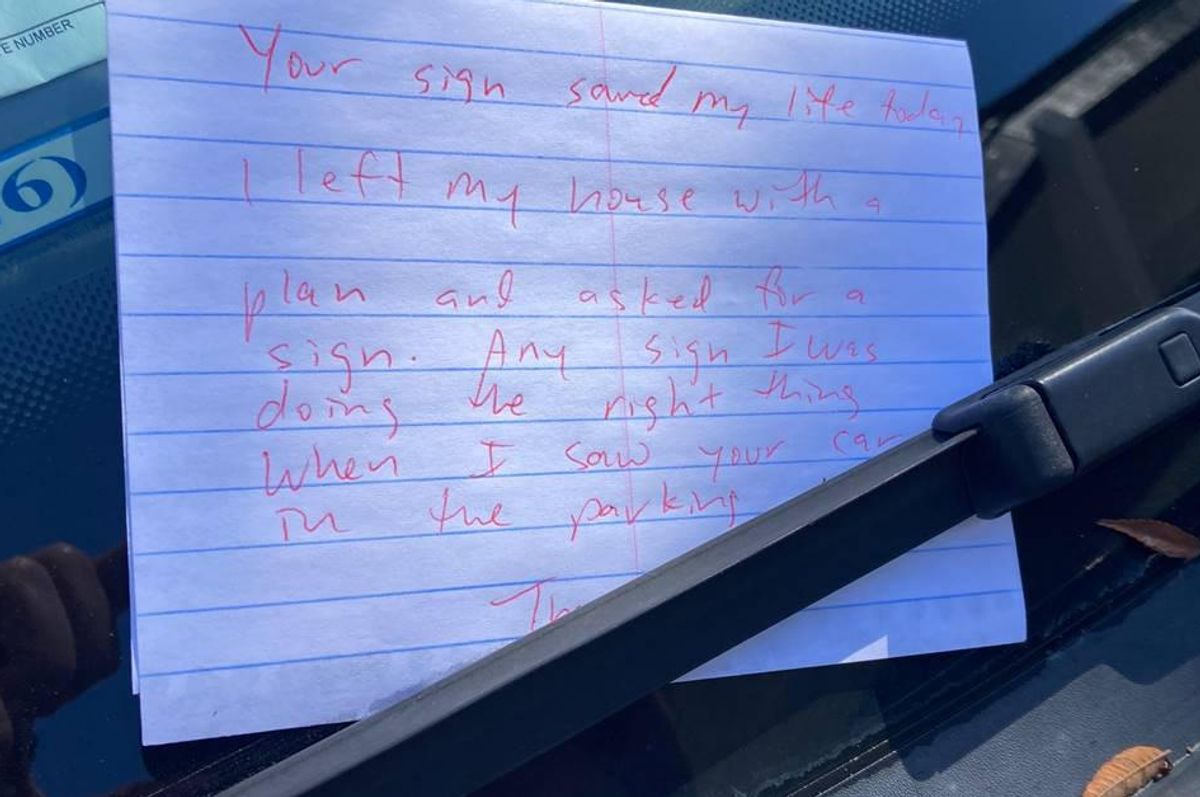'You saved my life': Suicidal person's life is changed after reading a homemade bumper sticker
One kind note can change the world.

A recreation of the note left on Brooke Lacey's car.
If you are having thoughts about taking your own life, or know of anyone who is in need of help, please call the National Suicide Prevention Lifeline at 1-800-273-TALK (273-8255) or text "HOME" to the Crisis Text Line: 741741.
There’s an old Hebrew saying that if you “save one life, you save the world entire.” Who knows if Brooke Lacey, 22, had that lofty goal when she began a campaign in 2020 to help uplift people’s spirits during the first COVID-19 wave. But her kind efforts may have done just that.
Lacey has struggled with mental health issues throughout her life and she knew that people like her were going to have a really hard time during COVID-19 lockdowns. A study from May 2021 found that the New Zealand population had “higher depression and anxiety compared with population norms.” The study also found that “younger people” and “those most at risk of COVID-19 reported poorer mental health.”
To help those who may be struggling, Lacey printed 600 stickers with an uplifting message and posted them around places where people may take their lives, including trains, bridges and large bodies of water in Wellington, New Zealand. She also made a bumper sticker with the same message for her car.
The stickers spoke directly to those who may be contemplating taking their own life. “Please don’t take your life today,” the stickers read. “The world is so much better with you in it. More than you realize, stay.”
In 2022, Lacey parked her car in her university’s lot and when she returned to her vehicle to leave, she noticed a note was affixed to the windshield. Thinking it was someone complaining about how she parked or a ticket, she prepared for the worst but wound up being blindsided by the positive message.
A driver\u2019s bumper sticker has saved a stranger\u2019s life.\n\nAfter her own battle with depression 22-year-old university student Brooke Lacey was inspired to create a batch of 600 signs to inspire those battling mental illness.\n\n#StarFMNews919 @Star919FMpic.twitter.com/0SSHhUvyvK— StarFMNews919 (@StarFMNews919) 1645525333
A 22 year New Zealand student called Brooke Lacey, who'd suffered with depression created some bumper stickers to help others who might be going through a similar experience. Recently she found a heartfelt note under her windscreen wiper to thank herpic.twitter.com/kFfu9wtXnN— Giles Paley-Phillips (@Giles Paley-Phillips) 1645468625
“I left my house with a plan and asked for a sign, any sign, I was doing the right thing when I saw your car in the parking lot. Thank you,” the note read. At first, Lacey wasn’t sure what the person was referring to, then she remembered her homemade bumper sticker.
“I had these made so long ago, put one on my car and forgot about them, until now,” she tweeted on her since deactivated account. “I am so glad whoever you are chose to stay today. You never know who needs this reminder.”
Now, it’s unclear exactly what the person’s “plan” was, but there's no doubt that Lacey’s bumper sticker inspired them to choose life. Let’s hope that the sticker also inspired them to seek professional help for whatever difficulties they are going through.
Whether it was intentional or not, Lacey’s sticker was effective because it followed one of the most important strategies that people use at suicide hotlines. According to Science.org, it’s of utmost importance that people contemplating suicide are handled with “respect and empathy.”
Lacey's story is a beautiful reminder of the power that one simple, thoughtful gesture can have on another person’s life. Every day, there are people all around us who are looking for a sign to give them a reason keep going. Whether it’s a hug, a smile, or the right message in the right place at the right time, we should all be like Lacey and make sure everyone knows that the world is better with them in it. In fact, much more than they ever realize.
This article originally appeared three years ago.

